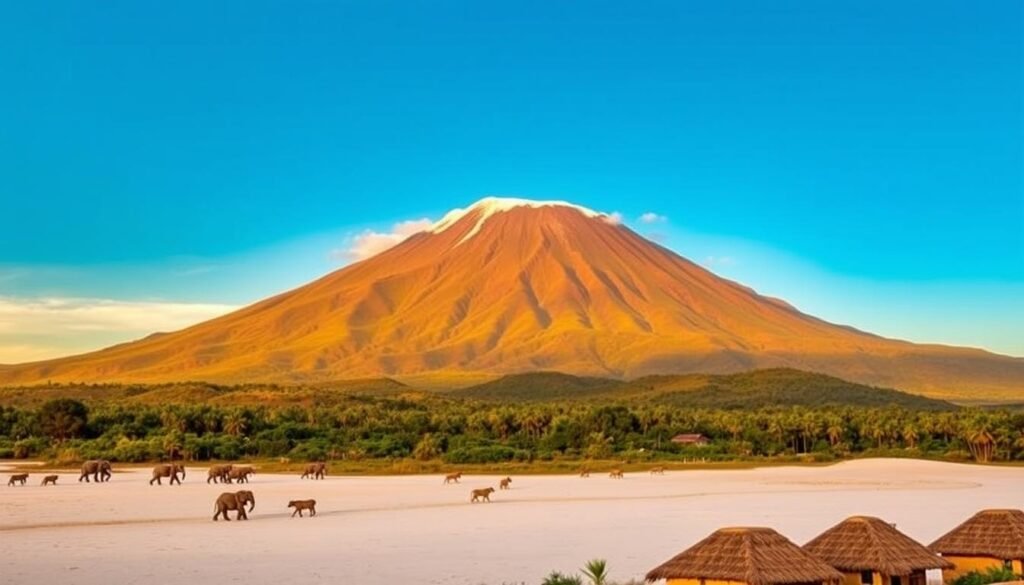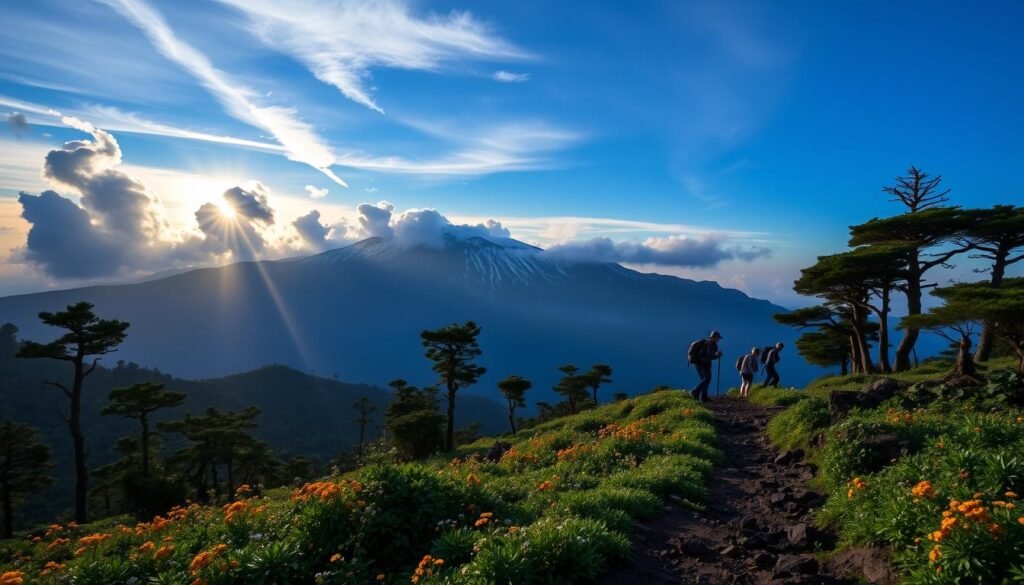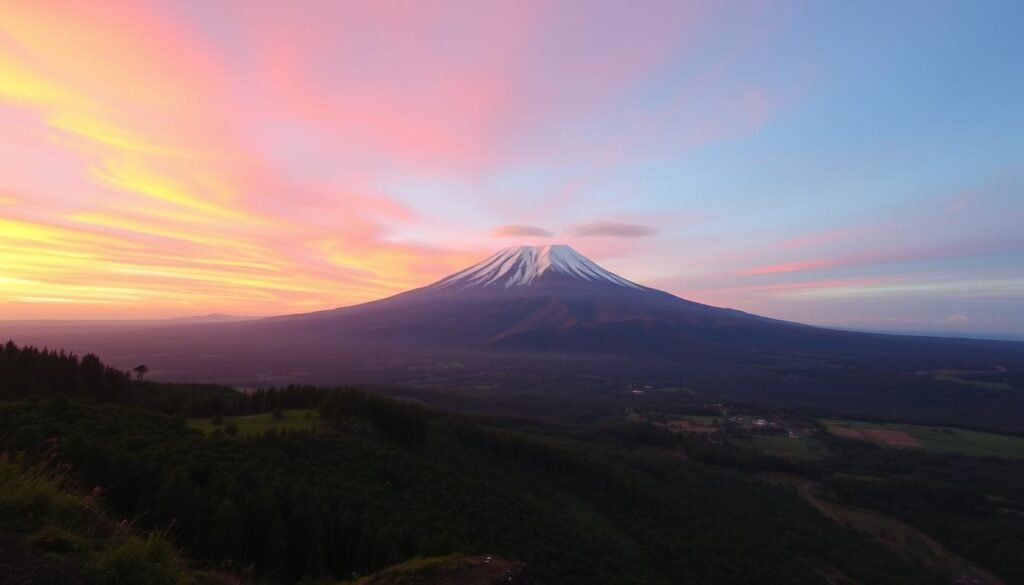Africa calls to adventure, from its savannas to snow-capped peaks. I felt this call, leading me to Tanzania. Here, I found legendary wildlife, tribal cultures, and nature’s grandeur. My journey, a Kilimanjaro tour, challenged my spirit and showed Africa’s beauty.
Every step towards Kilimanjaro’s summit and each safari drive in the Serengeti showed me awe. Zanzibar’s spice-scented streets and ivory sands brought me peace. Now, I invite you to find your adventure in Tanzania’s wilderness.
Key Takeaways
- Embrace a compelling 16-day African adventure with Tanzania’s diverse landscapes as your backdrop.
- Tackle Mount Kilimanjaro on a 6-day climb utilizing the picturesque Lemosho Route.
- Experience the thrill of the wild in pop-up roof 4×4 vehicles, with a max of 7 adventurers per tour to ensure intimate encounters.
- Dive into the cultural and natural wonders of destinations such as the Serengeti National Park, Ngorongoro Crater, and the enchanting island of Zanzibar.
- Enjoy a seamless adventure with included airport transfers and an array of accommodations, from budget-friendly camping to comfortable mid-range hotels.
- Witness wildlife spectacles, including the Big 5 and the annual wildebeest migration.
- Culminate your journey with tranquil Zanzibar beach relaxation and a fascinating historical tour in Stone Town.
Embarking on the Tanzanian Adventure: A Gateway to Thrills
The excitement of a real Tanzania adventure starts when you arrive at Kilimanjaro Airport. The vibrant energy of Africa calls you, leading to Moshi town. Here, you’ll find stunning landscapes and a rich cultural heritage.
Before you begin, you’ll get important briefings and checks. These steps are key to a smooth and exciting journey.
Arrival in Tanzania: First Impressions and Preparations
Arriving in Tanzania, you feel the thrill of a new adventure. Kilimanjaro Airport is your entry point to Tanzania’s adventure world. The drive to Moshi town is a colorful introduction to the beauty and wonders you’ll see.
Here, you’ll prepare for your climb up Mount Kilimanjaro. You’ll check your gear and get all the information you need.
Cultural Nuances and Engaging with Locals
Meeting the local community is a must for a true Tanzania adventure. Moshi town welcomes you with open arms, offering a mix of cultural experiences. From lively markets to peaceful coffee farms, you’ll feel the warmth of Tanzanian hospitality.
Every interaction, from local guides to artisans, adds to your journey. It’s a chance to make real connections and appreciate Tanzania’s diverse culture.

Scaling the Heights: Climbing Mount Kilimanjaro
My adventure to conquer Mount Kilimanjaro started with picking the best route. There are many paths, each with its own charm. Choosing the right one was key for a successful climb.
Choosing the Right Kilimanjaro Route for You
I chose the Lemosho route for its stunning views and high success rate. It begins on the western side of the mountain and takes about 8 days. This allows for good acclimatization, which is vital for high altitudes.
The route’s gradual climb helps my body adjust to the altitude. This reduces health risks during the climb.

Importance of Acclimatization and Altitude Sickness Prevention
High altitudes pose big challenges, and preventing altitude sickness is crucial. My plan on the Lemosho route was to climb high during the day and sleep low at night. This “climb high, sleep low” method lowered my risk of altitude sickness.
I also took Diamox, a medicine for preventing and treating altitude sickness symptoms. Reaching Uhuru Peak was thrilling, thanks to careful planning and precautions. Climbing Kilimanjaro via Lemosho was incredibly rewarding, combining natural beauty, physical challenge, and strategic ascent.
The Thrill of a Serengeti Safari Adventure
Going on a Serengeti safari is an unforgettable experience. It puts you right in the heart of African wildlife and the Great Migration. This journey through Tanzania’s Serengeti National Park shows you the true beauty of wild nature.
Exploring the Untamed Wilderness
The Serengeti is vast and full of wonders. It has geological marvels like the Gol Mountains and the active Ol Doinyo Lengai volcano. The park’s landscape is as varied as the animals it hosts.
For bird lovers, the Serengeti is a dream come true. It’s home to over 500 bird species. This makes it a paradise for birdwatchers.
An Encounter with Africa’s Majestic Wildlife
Seeing the Big Five—lions, elephants, leopards, buffalos, and rhinos—is a highlight of any safari. The Serengeti also has cheetahs and meerkats. These animals add to the park’s rich ecosystem.
Traveling through the park, you feel a strong bond with nature. Watching these animals in their natural habitat is awe-inspiring.
The Great Migration is a sight to behold, happening from June to October. About 1.5 million wildebeest move across the plains. It’s a stunning display of nature’s power and the animals’ fight for survival.
| Statistic | Information |
|---|---|
| Recommended Safari Duration | 4 to 5 days |
| Distance from Kilimanjaro International Airport to Serengeti | 200 miles (320 kilometers) |
| Number of Bird Species | Over 500 |
| Great Migration Timing | June to October |
| Major Airlines | KLM Royal Dutch Airlines, Turkish Airlines, Kenya Airways, Ethiopian Airlines |
| Key Wildlife Species | The Big Five: Lion, Elephant, Leopard, Buffalo, Rhino |
Zanzibar: A Piece of Island Paradise
After climbing Kilimanjaro and exploring the Serengeti, Zanzibar is a peaceful escape. It’s famous for its beautiful beaches and underwater life. Here, enjoying the coast is a way of life.
Zanzibar is a short trip from Tanzania’s mainland. It has clear waters and sandy beaches. The beaches are perfect for those who love the sun or want to explore Stone Town’s culture.
Sun, Sea, and Sand: Zanzibar’s Beachfront Leisure
Zanzibar’s beaches are more than just pretty views. They offer a peaceful retreat in nature. You can swim in the Indian Ocean or relax on the sand. For thrill-seekers, the coral reefs are great for diving and snorkeling.
From History to Relaxation: Embracing Zanzibar’s Coastal Offerings
Zanzibar is also rich in history, seen in Stone Town’s old buildings. Places like the Old Slave Market and the House of Wonders tell stories of the past.
The island also celebrates its culture with festivals like Sauti za Busara. These events showcase local arts and bring together music, dance, and film.
| Aspect | Details |
|---|---|
| Festivals | Annual events including Sauti za Busara, Zanzibar Jazz Festival, ZIFF |
| Top Attractions | Stone Town, Mnemba Atoll, Chumbe Island |
| Flora and Fauna | Home to over 4,500 plant species and diverse wildlife including red colobus monkeys and lemurs |
| Best Travel Period | High season from July to September, avoids the rainy months of April to May |
| Typical Costs | Holiday for two costing approximately $4,285 per week |
Zanzibar is more than a beach vacation. It’s a mix of history, culture, and nature. It’s a key part of any Tanzanian adventure.
The Essence of Zanzibari Heritage: Exploring Stone Town
Walking through Stone Town’s narrow alleys, I felt the rich history and diversity of Zanzibar. This place is a UNESCO World Heritage Site, showing the mix of Arab, Persian, Indian, and European cultures. Its buildings tell stories of the past.
A UNESCO World Heritage Site Teeming with History
Stone Town’s buildings and streets hold a deep history. Every corner tells of Zanzibar’s connections with the world through trade. It was a key trading hub, shaping the island’s culture and economy. This made it a UNESCO World Heritage Site, showing its global importance.
Captivating Architecture and Timeless Street Mazes
The architecture in Stone Town shows the mix of cultures. You see houses with big verandas, carved doors, and narrow streets. These buildings and streets are a testament to Zanzibar’s heritage, attracting scholars and tourists.
Stone Town is also alive with Zanzibar’s culture. The bazaars offer handmade crafts and spices fill the air. It’s a place where you can truly experience Zanzibari heritage.
| Venue | Experience Offered | Timing |
|---|---|---|
| Forodhani Garden Markets | Culinary delights, local crafts | Late afternoon to 9 pm |
| Mtoni Palace Ruins | Cultural performances, music and buffet | Tuesdays and Fridays |
| Darajani Market | Spices, fresh produce, seafood | Open daily |
| Old Slave Market | Historical tours, educational insights | Open daily |
| Hamami Persian Baths | Architectural tours, historical insights | Open daily |
Exploring Stone Town is more than just seeing places. It’s a journey through centuries of history. Each stone and building tells the story of Swahili culture and Zanzibari heritage.
Journey Essentials for African Adventures
When planning a trip to Tanzania, knowing what to pack is key. You’ll need different items for the mountains, savannas, and beaches. The right gear makes your trip better.
Your Comprehensive Packing List for Kilimanjaro, Safari, and Zanzibar
Getting your packing right is important. For Kilimanjaro, bring warm clothes, sturdy boots, and lots of sunblock. For the safari, wear camouflage or neutral colors, a big hat, and good binoculars. Zanzibar calls for light clothes, swimsuits, and comfy sandals.
Tailoring Your Gear for Diverse Tanzanian Climates
Tanzania’s weather changes a lot. Kilimanjaro is cool and windy, while Zanzibar is warm and sunny. Dressing right for each place is crucial. Wear layers for Kilimanjaro and light clothes for the coast.
- Warm clothing: Necessary for the cool nights and high altitudes of Kilimanjaro.
- Protective safari gear: Helps in blending with the environment and protecting from sun and insects.
- Beach attire: Essential for the laid-back, tropical vibe of Zanzibar.
| Activity | Essential Gears | Recommended Quantity |
|---|---|---|
| Kilimanjaro Climbing | Thermal Layers, Hiking Boots, Headgear | Multiple layers, 1 pair boots, 2 hats |
| Safari in Serengeti | Neutral-toned clothes, Binoculars, Sunscreen | 3-4 outfits, 1 pair binoculars, 1 bottle |
| Relaxing in Zanzibar | Swimwear, Light dresses, Sandals | 2-3 swimsuits, 2-3 dresses, 1 pair sandals |
Having the right gear makes your trip to Tanzania great. Whether climbing Kilimanjaro, watching lions, or relaxing in Zanzibar, the right equipment is key. It ensures you have a memorable adventure.
Health and Safety Measures for Tanzanian Travel
Planning a trip to Tanzania means focusing on health and safety. Knowing about Tanzania travel health and safety is key. This includes getting the right vaccinations, learning about malaria prevention, and having good travel insurance.
Escaping the Risks with Appropriate Vaccinations and Preventatives
Travelers to Tanzania need to be up-to-date on vaccinations. Diseases like cholera and typhoid fever are common. Getting vaccinated against these is crucial.
Malaria is a big risk in Tanzania. To prevent it, take medicine, use repellent, and sleep in mosquito nets. Also, be careful with freshwater in rural areas to avoid schistosomiasis.
Ensuring Peace of Mind with Adequate Travel Insurance
Getting good travel insurance is essential for Tanzania. It should cover accidents, medical costs, evacuations, and trip cancellations. With diseases like pneumonia and HIV common, you need insurance that covers medical treatment and repatriation.
Travel insurance is even more important for high-altitude activities like Mount Kilimanjaro. Altitude sickness can be serious. Having insurance for accidents and rescue can save your life.
By taking these steps for Tanzania travel health and safety, you can greatly reduce risks. This way, your trip to Tanzania will be safe and memorable.
Financial Planning for the Tanzanian Excursion
Knowing the costs of a trip to Tanzania is key for a great experience. You’ll need to think about safari costs, planning for Kilimanjaro, and tipping in East Africa. Good planning can save you money and reduce stress.
Budget Tips for Safari Treks and Coastal Escapes
The cost of a Tanzania trip changes based on the season, location, and travel type. Traveling in the high season means higher prices, while the low season offers discounts. For example, you can save up to 50% during the low season (March to May).
- Staying outside major national parks can cut accommodation costs.
- Traveling in groups can lower costs per person on safaris.
- Choosing budget safaris with basic camping can save money.
- Adding activities like climbing Mount Kilimanjaro can increase costs, averaging $3,025 per person.
Don’t forget to budget for extra expenses like drinks and tips. Aim for $30-$50 USD per day for these.
Tipping Practices and Miscellaneous Expenses in East Africa
Tipping in East Africa varies by service. It’s important to include it in your budget. For example, tip safari drivers or guides $30-$50 USD per day, chefs $15 USD, and porters $10 USD. Transfer drivers usually get tips of $5 to $10 USD.
- Use newer US Dollar bills (post-2006) for tips and big expenses, as older notes might not be accepted.
- Keep some Tanzanian Shilling for small purchases to avoid trouble.
Credit cards are accepted, but expect a 5-15% processing fee. This is important for budgeting for Kilimanjaro or other activities.
By managing your money well, you can enjoy Tanzania’s beauty and culture more. You won’t have to worry about unexpected expenses.
Crafting Your Tanzanian Adventure with Expert Tour Operators
Tanzania’s beauty isn’t just in its landscapes or wildlife. It’s also in the quality of your tour operator. With over 50 diverse destinations, from Kilimanjaro’s snow to Zanzibar’s waters, choosing the right guides is key.
Choosing Competent Guides for Kilimanjaro and the Safari
For a memorable Kilimanjaro climb, pick seasoned tour operators like Zara Tanzania Adventures. They’ve been leading tours since 1986. They plan every detail, from routes like Lemosho and Marangu, to fit your needs.
For safaris, your guide’s expertise makes all the difference. They share insights on Tarangire and Ngorongoro. They also keep you safe and comfortable.
Orchestrating Your Trip for an Effortless Tanzanian Experience
Top tour operators in Tanzania focus on smooth travel logistics. Zara Tanzania Adventures, for example, handles everything from your arrival to your climb. They ensure a hassle-free trip.
Choosing operators with customizable itineraries and valuing feedback makes your trip personal. Here’s what a trusted operator offers:
| Service Offered | Description |
|---|---|
| Kilimanjaro Routes | Guided treks on Marangu, Machame, Lemosho, and Rongai. |
| Safari Experience | Customizable tours in iconic parks like Serengeti and Ngorongoro. |
| Zanzibar Beach Tours | Explore pristine beaches and rich marine ecosystems. |
| Accommodation | Bookings in 3-5 star hotels, boutique options, and spa resorts. |
| Airport Services | Organized arrival services for seamless entry into Tanzania. |
Choosing the right tour operators in Tanzania, like Zara Tanzania Adventures, can make your trip unforgettable. You can enjoy Tanzania’s beauty and culture without any worries.
Conclusion
My trip to Tanzania showed me a world full of natural wonders. It’s a key part of African exploration and a symbol of human strength. Climbing Mount Kilimanjaro was more than a physical test. It was a deep connection with nature, where every step was a journey.
The Serengeti and Ngorongoro Crater offer unforgettable wildlife encounters. These moments will stay with me forever. Thanks to local tour operators, traveling to Tanzania is easier than ever. Local guides made my trip safer and more meaningful, teaching me about Tanzania’s ecosystems and wildlife.
Tanzania’s true essence is found in its safaris, mountain climbs, and Zanzibar’s beaches. My journey was a mix of excitement and calm. Whether driving myself or following local guides, every day showed Tanzania’s beauty. It’s a top spot for both thrill-seekers and those seeking peace.

